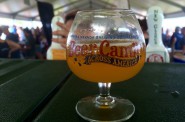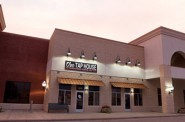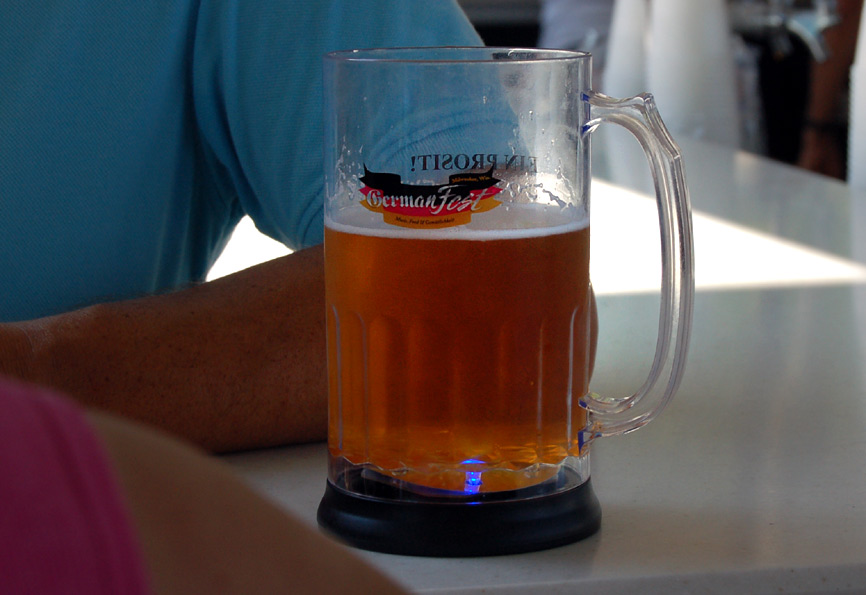27 Myths About Beer
Never has one refreshing drink been so misunderstood. Here’s the true take on all those myths.
It’s remarkable how misunderstood beer can be. And the rise of craft brewers and beer culture has only multiplied the misinformation. So the next time there’s a barroom debate on beer, you might consult this list to answer all the myths and misunderstandings.
Beer should be served cold
Many American consumers insist on this. Some mock our European cousins for drinking their beer warm or cellar temperature. In fact, beer isn’t at its best ice cold. For example, lagers are best between 42 and 48 degrees, ales between 44 and 52, and stouts at around 55 degrees. In fact, the only beers that should be served ice cold are high gravity-beers such as old ales (the style, not an old beer), barleywine, and barrel-aged stouts.
Cold filtered beer is superior beer
Actually, there is no such thing as warm filtering; the only kind of filtering is cold. All beers must be kept at a very cold temperature for the lagering process to take place – common lagering temperatures are 33-45 degrees farenheit.
A beer is a beer
Yes, there are still die-hards out there making this ridiculous claim. In reality, between the two classifications of beer, which are ale and lager, there are at least 70 mother styles with countless secondary styles branching off into different worlds of flavor, aroma, color, and bitterness.
All dark beers are the same
Schwarzbier, Dunkel, Stout are the three most common dark beers. While all are dark in color they are greatly different in terms of specialty malts, hops, and yeast. For example, schwarzbier relies on black malt for its color, and somewhat for its bitterness; a stout uses black malt, too, but also roasted barley, and flaked oats or wheat for head retention; a dunkel forgoes the black malt in favor of a dark crystal malt and chocolate malt for its color and sweetness. Lastly, when a beer is referred to as Dark or Special Dark, chances are you’re drinking a dunkel or a schwarzbier, respectively.
All beer is bitter
Bitterness is determined by the level of International Bitterness Units, or IBU’s, in your beer. Bitterness is mainly derived from hops, therefore a beer can be as bitter as the brewer wishes. A prime example of a weakly hopped beer is a milk stout, which is prized for its sweetness over its bitterness. On the flip side, a triple IPA is brewed to be very bitter.
American lagers aren’t really pilsners
This one has caused more than its fair share of bar arguments and angry comments on social media. The American Adjunct Lager originated as a German Pilsner, which is traditionally made with hallertau hops, pilsner malt, water, and German lager yeast, while the original Czech recipe swaps Hallertau for Saaz and German yeast for Czech. The American variant that has come to dominate the American market is essentially a German Pilsner modified to use less hops to dial back on bitterness, and a portion of the base malt substituted with an adjunct such as corn or rice to make for a lighter body and color. As a result, we get an American variant of the classic pilsner that appeals more to the masses.
Lager is light and ale is dark
This myth comes from the fact that the most common lager on the market is the golden American Adjunct. But in fact, both ales and lagers can range from pale golden to black. An example of a dark lager is Leinenkugel’s Creamy Dark and and example of a light ale is Delirium Tremens, which is a Belgium Strong Pale Ale.
Head is a bad thing
While some find head to be appealing to look at but awful to taste, head serves a purpose – it traps in flavor and aroma, preserving your beer. The more complex the beer, the more you’ll want a frothing cap guarding your beer from the air.
Triple hop brewed beers are special
Another sore subject that tends to divide beer lovers, especially in Milwaukee where this slogan, “triple hop brewed,” has become synonymous with local brewing giant Miler Coors. For anyone with a decent knowledge of brewing, the sales pitch is silly since almost all beer styles are made with three additions of hops, one at the beginning to achieve bitterness, another halfway through for flavor, and a third in the final minutes for aroma. Most interestingly, some beers only use a single type of hops, but use it three times.
Drinking beer before liquor causes a terrible hangover
Not really. Like anything with alcohol, beer will cause you to expel water more quickly. As a result, you become dehydrated and will suffer a hangover if you don’t replace the lost water. Generally, most microbrews are on par with a shot of rum or whisky in terms of total alcohol per serving. The difference is that beer is consumed slower, meaning you have a greater chance of sobering up than you do with a shot of liquor, thus giving you a better chance to rehydrate before your bladder kicks into overdrive.
European beer is skunky
In the past people have attributed a skunky flavor to the style of European lagers, but in actuality, this is the product of light spoilage caused by the green bottles being exposed to sunlight. If your beer tastes skunky, it’s not a true version of the beer, it means it’s technically gone bad (though some enjoy it that way).
Draft is Best for Beer
This is a matter of preference, and may depend on the particular beer, but draft beer, despite its many virtues, does present an issue that bottles and cans don’t – dirty lines.
Bottle is better than can
Cans have actually been proven to better preserve beer. Also, depending on whether the bottles use steel caps and not aluminum, they can give the beer a metallic taste if consumed from the bottle itself. To test what material your favorite beer uses, grab a magnet – steel is magnetic, aluminum is not. If it’s steel, just use a glass.
Sour beer is bad beer
Yes and no. A sour beer means its been infected by microorganisms in the air and has spoiled. But Belgian brewers have been making purposefully sour beers for centuries and they’re just now hitting their stride stateside.
Beer has an expiration date
Quite possibly the most ingenious move by brewers was to put an “expiration date” on their beer. Since we’re all conditioned to fear consuming something past the printed date, we’ll throw out the old and buy a fresh batch. But for beer, there really isn’t an expiration date; the date is more of a warning that the beer will begin to change from its original flavor. If the beer is kept in a cool, dark place, aging your beer should have no adverse effects, and just might improve it. Of course, if your beer is kept in a humid spot where the sunlight is constantly beating on the bottles, you can count on a skunky beer.
Beer is weak in comparison to wine
When comparing the vast majority of beers, this is true, considering the average ABV of wine and beer is 11 and 5 percent respectively. Of course, there do exist a few varieties of beer that are on par with wine in ABV. One such variety is, appropriately, named Barley Wine.
Beer shouldn’t have sediment
Filtered beer is done strictly for appeal and mass production. Meanwhile, it’s customary in parts of Belgium to leave the sediment and consume it along with the beer. This may sound disgusting, but yeast sediment is rich in B vitamins. Sediment is also typically found in home-brewed beers and unfiltered beer is becoming trendy in the craft-brew world. Lastly, if you’ve had a wheat beer, you’ve likely had an unfiltered beer.
Ales and lagers are the same thing
Nope. Ales are made with top fermenting yeast at warmer temperatures, while lager is brewed with bottom fermenting yeast at colder temperatures. To further differentiate, a lager is held in cold storage for several months, while ale is ready for bottling and conditioning the moment fermentation is complete.
Beer will make you fat
The average beer can range from 100 to 200 calories, while the average adult male burns 2,000 calories per day without exercise. While binge drinking can surely add on the calories, the bigger contributor to that “beer belly” may be the food you eat when you drink, especially fast food like fries or pizza. A Miller Lite is around 100 calories, a Big Mac with fries is around 1,000.
Beer should be kept warm until ready
To an American, warm is anything not refrigerated, and by that definition, warm is all wrong. As noted, beer is best kept in a cool, dark place such as a basement. Doing so will ensure minimal light exposure and avoid any drastic change in temperature, both of which will spoil your beer.
Beer is a niche drink
This myth suggests beer is only a European and American drink, which couldn’t be farther from the truth. Archaelogical evidence has discovered beer on every continent with a variety of base ingredients including maize, rice, wheat, barley, and sorghum. In fact, Dogfish Head Brewing Co. has an entire line of brews from around the ancient world including China, Egypt, Turkey, Finland, and Mexico.
The darker the beer, the stronger
An enduring myth, but a beer’s color has nothing to do with the alcohol content. What determines color is the type of malts used, while alcohol content is determined by the type and amount of malt used, due to the fermentable sugars extracted and converted to alcohol by the yeast. For example, a schwarsbier is the darkest german style, but the black malt that gives it its namesake color (Schwarz is German for black) goes through an intense kilning process which destroys the sugar in the barley, meaning it lends only color to the beer.
Yes and no. A light beer can range between 100 and 120 calories, while a regular beer can range between 160 and 200 calories. But the stronger taste in the regular beer may leave you more satisfied and needing to drink less. And don’t forget all those vitamins in beer with sediment.
Mexican Cerveza is its own unique style
Most of the more popular Mexican beers such as Modelo, Corona, and Dos Equis, aren’t a style of their own, but simply Vienna lagers and German Dunkels introduced by a wave of German and Austrian settlers that flooded our southern neighbor in the mid-19th century during the short-lived Second Mexican Empire headed by an Austrian Archduke.
Oktoberfest is dedicated to beer
Not the full story. Oktoberfest, or Wiesn as it is called in Bavaria, is an annual Bavarian cultural festival that originated in 1810 as a public celebration of the marriage of Crown Prince Ludwig of Bavaria and Princess Therese of Saxe-Hildburghausen. The event became a yearly celebration and grew with each year, except for the 24 years in which it was cancelled, most prominently due to the Napoleanic Wars and World War Two. The event eventually spawned a special seasonal beer known to many as Oktoberfest lager, but to Germans as Marzen.
Craft beer is always strong and tastes like perfume
Both are common complaint from macro-brew drinkers. As stated earlier, the average beer ABV is 5 percent. This isn’t much higher than the average macro brew ABV of around 4.2 percent. The reason why macro brew fans find craft brews to be stronger and perfume-like is the increased usage of hops and the fact that most craft brews are full bodied, and not boiled to cut down on calories from alcohol. And there is a huge variety of micro-brews so any generalization is misleading.
Beer makes you stupid
Given some of these myths, there might be reason to answer yes. The reality if that any alcoholic drinks, when taken immoderately, can inhibit your cognitive functions, thus leading to more immature actions. But beer is no worse than other drinks and as noted, works slower on the body than liquor. And a good night’s sleep will restore your brain to its former capacity. Then you’ll have to blame something else for any stupidity.
Beer City
-
The Crowd Rules At MobCraft Brewery
 Jul 7th, 2016 by Joey Grihalva
Jul 7th, 2016 by Joey Grihalva
-
Sierra Nevada Beer Camp Was a Winner
 Jun 13th, 2016 by Joey Grihalva
Jun 13th, 2016 by Joey Grihalva
-
The Rise of O’so Brewing Co.
 Dec 1st, 2015 by Christophor Rick
Dec 1st, 2015 by Christophor Rick
























“Actually, there is no such thing as warm filtering; the only kind of filtering is cold. All beers must be kept at a very cold temperature for the lagering process to take place – common lagering temperatures are 33-45 degrees Fahrenheit(sp).”
Ale’s don’t require very cold temperatures. I’ve made many a summer ale letting it ferment in my basement or even dark closet. Attempting to lager ale yeast will take longer at best and will delay the time from brew to bottle (or keg).